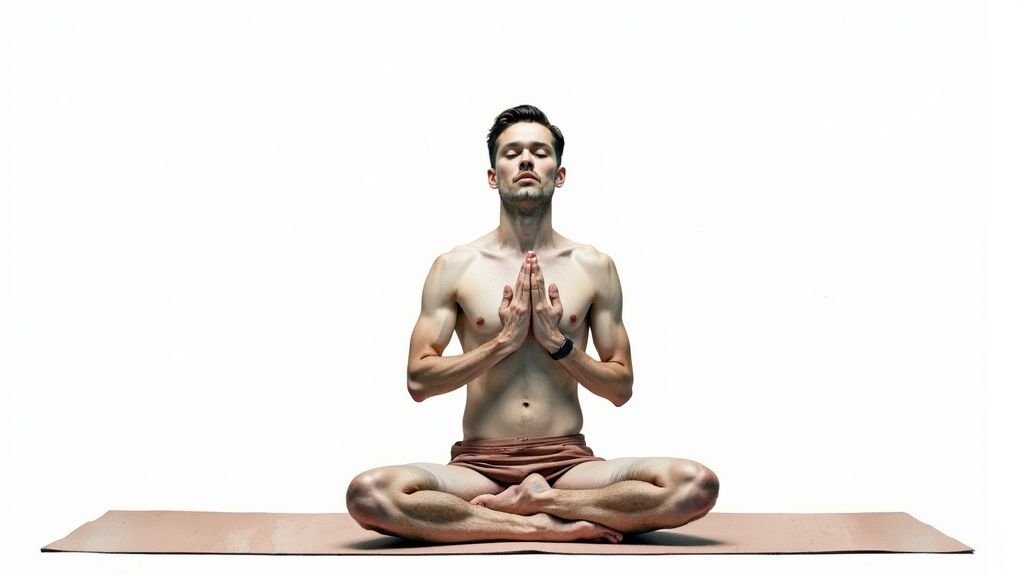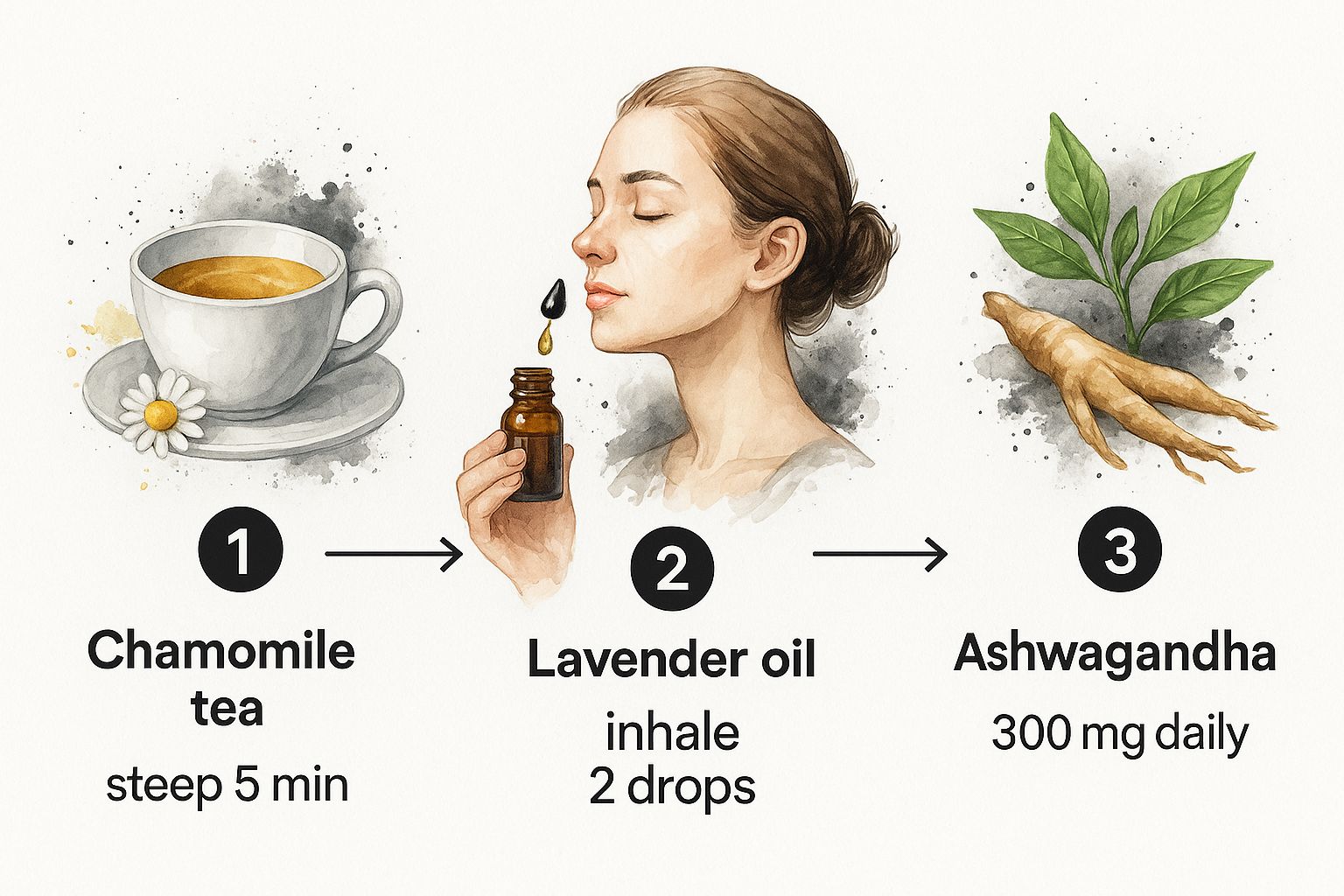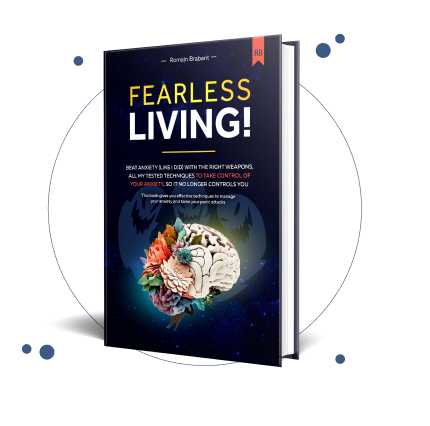
If you're reading this, you've probably felt it—that overwhelming weight of anxiety. The racing thoughts, the tight chest, the feeling that it’s running your life. It can feel like a relentless cycle with no way out.
But that feeling isn't permanent. Real, lasting relief is not only possible, but it's something you can absolutely achieve. A future where you feel calm, in control, and free from panic is within your reach.
The journey to a calmer life isn't about finding some magic button. It’s about making small, consistent shifts that build on each other over time. Think of it as creating your own personal toolkit, filled with practical, natural strategies that empower you to heal and reclaim your peace.
You Are Not Alone in This
The isolation that anxiety brings is a heavy burden, but millions of people understand exactly what you're going through. Global events have really shone a light on just how common these feelings are.
In fact, the COVID-19 pandemic triggered a 25% increase in the worldwide prevalence of anxiety during its first year alone. The combination of social isolation, fear, and financial stress pushed the need for accessible, natural mental health tools to the forefront. You can learn more about the WHO's findings on global mental health in their full report.
This isn't just a number; it's a powerful reminder that what you’re experiencing is a shared human condition. More importantly, it shows that looking for natural ways to manage anxiety is a completely valid and necessary step toward healing and feeling better.
The journey to a panic-free life starts with the very first step you decide to take. Your willingness to explore new tools is a powerful act of self-compassion and the beginning of change. Hope is real, and healing is possible.
A Practical Roadmap to a Quieter Mind
In this guide, we’re going to get practical. We'll explore how simple adjustments to your daily life can create profound changes in your mental state. No vague advice here—just a clear roadmap with actionable techniques to help you heal.
We’ll be covering:
- Breathing Techniques: Discover how to use your breath as an anchor to signal safety to your nervous system.
- Lifestyle Adjustments: Learn how small, daily habits around sleep, sunlight, and movement can build rock-solid resilience against anxiety.
- Nutritional Support: Understand the surprising connection between the food you eat and your mental state—and how to make it work for you, not against you.
Each strategy is a building block on your path to recovery. The goal is to give you the knowledge and the tools to quiet the internal noise, handle those overwhelming feelings, and finally feel like you're back in the driver's seat of your own life.
Let's take that first step together.
Using Your Breath to Instantly Calm Anxiety
When a wave of panic hits, your first instinct might be to feel powerless. But you possess a built-in anchor that can ground you in seconds—your breath. It's the most immediate and effective tool you have to signal to your body that you are safe and in control.

This isn’t just about “taking a deep breath” and hoping for the best. Intentional breathing is a direct line to your nervous system. By consciously slowing your breathing, you can actively shift your body out of that frantic 'fight-or-flight' state and into a calm, restorative 'rest-and-digest' mode.
This simple, deliberate action can dramatically reduce the physical symptoms of anxiety, reminding you that you have the power to influence how you feel.
The Science of a Calmer State
When anxiety spikes, breathing often becomes shallow and rapid, happening mostly in the chest. This is your body's alarm system, and that breathing pattern tells your brain that danger is present, which just keeps the cycle of panic going.
Deep, diaphragmatic breathing—breathing from your belly—does the exact opposite. It stimulates the vagus nerve, a major player in your parasympathetic nervous system. This stimulation sends a powerful message back to your brain to slow your heart rate, lower your blood pressure, and relax your muscles.
Mastering your breath is like learning the secret language of your own nervous system. It's a skill that gives you the power to respond to anxiety with calm authority, rather than reacting with fear. This is a foundational step toward living panic-free.
Practical Breathing Techniques for Real Life
Knowing why it works is one thing. Knowing how to do it when you're feeling overwhelmed is what truly matters.
These techniques are discreet and can be used anywhere, from a stressful meeting to a crowded grocery store. No one has to know you're doing them.
The 4-7-8 Breath
This technique, developed by Dr. Andrew Weil, is incredibly effective for quieting a racing mind, particularly if you're trying to fall asleep. Think of it as a natural tranquilizer for your nervous system.
Here's how it works:
- First, let all the air out of your lungs with a gentle whoosh sound through your mouth.
- Close your mouth and inhale quietly through your nose for a mental count of four.
- Now, hold your breath for a count of seven. This is the most crucial part of the practice.
- Finally, exhale completely through your mouth, making another whoosh sound, for a count of eight.
Repeat this cycle three or four times. The key is that long, controlled exhale—it’s deeply calming.
Box Breathing for Immediate Grounding
Favored by people who need to stay calm under pressure, like Navy SEALs and first responders, box breathing is excellent for regaining focus and control. It's easy to remember because all sides are equal, just like a box.
- Inhale: Breathe in slowly through your nose for a count of four.
- Hold: Hold that breath for a count of four.
- Exhale: Gently release the breath through your mouth for a count of four.
- Hold: Keep your lungs empty for a count of four before you start again.
This rhythmic pattern forces you to slow down and brings a predictable order to the chaos of a panic moment.
For a deeper dive, you can explore more https://anxietychecklist.com/breathing-exercises-anxiety to add to your personal toolkit. By practicing these when you’re calm, you’ll build the muscle memory needed to use them effectively when anxiety strikes, empowering you on your journey to healing.
Building a Lifestyle That Fosters Resilience
While breathing exercises are fantastic for in-the-moment relief, the real game-changer for long-term freedom from anxiety is building a life that supports your nervous system from the ground up. This isn't about grand, sweeping changes. It’s about weaving small, consistent habits into your day that build resilience, making you less vulnerable to triggers and better equipped to handle life's curveballs.
Think of it like building a muscle. You can't just lift a heavy weight once and expect to be strong. You have to show up consistently. The same goes for your mental well-being. Each small, supportive choice you make strengthens your ability to stay calm and centered.
The Powerful Impact of Movement and Nature
We all know exercise is good for us, but when you're dealing with anxiety, the type of movement you choose really matters. You don't need to push yourself through a grueling high-intensity workout to feel better. In fact, gentle, consistent activity can be far more effective.
A simple, brisk 20-minute walk can work wonders, especially if you can do it in a park or another green space. There's solid science showing that time in nature actually lowers cortisol, our primary stress hormone. Another great option is restorative yoga. It's less about the workout and more about the "work-in," connecting your mind and body through slow, deliberate movements and deep breathing that directly soothe your nervous system.
Hope is not a passive wish, but an active practice. Each small, healthy choice you make is a vote for a future where you are in control, not your anxiety. This is how you build a life that feels safe and strong from the inside out.
Designing Your Day for Rest and Recovery
Building resilience isn't just about what you add to your day—it's also about fiercely protecting what restores you. And nothing is more restorative than sleep. A bad night's sleep can send your anxiety sensitivity through the roof, while quality rest is one of the most powerful natural tools you have on your path to healing.
Getting your sleep hygiene on point is a non-negotiable. Here are a few practical places to start:
- Embrace Morning Sunlight: Try to get at least 10-15 minutes of direct sunlight soon after you wake up. This is a powerful signal to your internal clock, helping to regulate your energy levels throughout the day and prepare you for sleep at night.
- Implement a "Digital Sunset": Power down all your screens—phone, tablet, TV—at least 60 minutes before you plan to sleep. The blue light they give off can mess with melatonin production, the hormone that tells your body it's time to rest.
- Keep It Cool: A cool room is your best friend for deep sleep. The ideal temperature is around 18°C or 65°F. Your body's core temperature naturally drops to initiate sleep, and a cool room helps that process along.
For a more structured approach to integrating these kinds of supportive habits, this ultimate daily self-care checklist is a fantastic resource. It gives you a great framework for building a daily routine that chips away at stress.
A simple herbal routine can also be a gentle nudge for your body to wind down. This infographic shows a simple way to incorporate calming herbs into your evening.

As you can see, you can layer different calming inputs—like chamomile tea, a lavender-scented bath, or ashwagandha—to create a simple but effective ritual. It’s these small, repeatable actions that truly form the foundation of a resilient lifestyle.
Nourishing Your Mind with an Anti-Anxiety Diet
The food you eat has a direct and powerful conversation with your brain. What you choose for breakfast, lunch, and dinner can either fuel the engine of anxiety or help apply the brakes. Believing that you can heal from anxiety involves recognizing every tool at your disposal, and your diet is one of the most accessible and impactful.

The connection between your gut and your mind is undeniable. A huge portion of your body's serotonin—a key mood-regulating neurotransmitter—is produced right in your gut. When your gut flora is happy and balanced, your mind is far more likely to feel calm and clear. This is where an anti-anxiety diet comes in, shifting the focus from temporary fixes to sustained, internal support.
It’s a journey of nourishment, not deprivation. And it offers incredible hope for a panic-free life.
Foods That Promote Calm and Stability
Think of your grocery list as a prescription for peace. Certain nutrients are absolute superstars when it comes to supporting brain function and calming a frazzled nervous system.
You can start by weaving in foods rich in magnesium, often called "nature's relaxant." Magnesium plays a crucial role in regulating the neurotransmitters that tell your body it's safe to unwind.
- Leafy Greens: Spinach, kale, and Swiss chard are packed with magnesium. A simple side salad or a handful of greens tossed into a smoothie is an easy way to get your daily dose.
- Nuts and Seeds: Almonds, cashews, and pumpkin seeds are excellent sources. A small handful makes for a fantastic anxiety-busting snack.
- Legumes: Lentils, chickpeas, and black beans offer a powerful combo of magnesium and fiber, which helps stabilize blood sugar and prevent those jarring mood swings.
Another key player is omega-3 fatty acids, which are vital for brain health. Fatty fish like salmon and mackerel are fantastic sources. For plant-based options, walnuts and chia seeds are excellent choices.
The Gut-Brain Connection
A healthy gut microbiome is your frontline defense in managing anxiety. Probiotics—the good bacteria living in your gut—help reduce inflammation and support the positive mood signals your brain relies on.
Fermented foods like yogurt with live cultures, kefir, sauerkraut, and kimchi are all great sources. If you want to dive deeper, this complete guide to natural probiotics is a great resource for understanding how to support your gut for overall well-being.
Healing anxiety isn’t about fighting a war inside your mind; it's about creating an internal environment where peace can naturally grow. Your food choices are the seeds.
Understanding Anxiety Triggers in Your Diet
Just as some foods can calm you, others can put your nervous system on high alert. Becoming mindful of these common triggers is a huge step toward feeling more in control.
The big three culprits are often:
- Caffeine: It directly stimulates your 'fight-or-flight' response, which can mimic the physical feelings of a panic attack.
- Sugar: Sugary foods cause your blood sugar to spike and then crash, a roller coaster that often leads to irritability, mood swings, and anxiety.
- Alcohol: While it might feel like it calms you down at first, alcohol disrupts sleep and can ramp up anxiety the very next day.
Making small swaps—like herbal tea instead of coffee or a piece of fruit instead of candy—can make a significant difference over time. You can learn more about how to structure these changes by reading our guide on lifestyle and diet changes for anxiety management.
Making these dietary adjustments is an accessible, natural way to reduce anxiety. This is especially crucial when you consider how widespread these struggles are. In the U.S., about 20% of adults experienced anxiety symptoms in 2022, yet globally, only about 25% of people with a disorder receive treatment. Accessible, natural methods are vital for closing that gap and offering hope.
Using Mindfulness to Break the Worry Cycle
Chronic worry can feel like a relentless hamster wheel, spinning you through endless "what-if" scenarios until you're exhausted and overwhelmed. Mindfulness is how you gently step off that wheel.
It’s not about forcefully emptying your mind or stopping your thoughts—an impossible task that just piles on more pressure. Instead, it’s about learning to observe your thoughts without getting tangled up in them.

Think of it as building a mental muscle. You're training your focus to shift from the storm of anxiety to the calm anchor of the present moment. This is a profound act of self-kindness that shows you that you are not your anxiety; you are the one who notices it. That realization alone is a cornerstone of hope, proving you can find peace even when worry shows up.
Grounding Yourself in the Present Moment
When you feel overwhelmed, your mind is usually stuck replaying the past or catastrophizing about the future. Grounding techniques are designed to pull your attention right back to the here and now, which is almost always much safer than your thoughts are telling you.
One of the most accessible exercises is the Body Scan Meditation. You don't need any special gear, just a quiet spot to sit or lie down for a few minutes.
- Start by closing your eyes and bringing your attention all the way down to your feet. Notice any sensations—warmth, coolness, the pressure against the floor—without judging them.
- Slowly, deliberately, move your focus up your body: to your calves, your knees, your thighs, and so on, until you reach the top of your head.
- Your mind will wander. That's a guarantee. When it does, just gently guide it back to the part of your body you were focused on.
This simple act of paying attention anchors you in your physical reality, providing an immediate escape from the abstract, chaotic world of worry. You can find more guided practices like this in our overview of meditation for anxiety.
Detaching from Anxious Thoughts
Another powerful mindfulness tool is a visualization exercise called "Leaves on a Stream." This practice is fantastic for creating distance from your thoughts, so you can see them for what they are—temporary mental events, not absolute facts.
Imagine yourself sitting beside a gently flowing stream. As each thought or feeling arises, simply place it on a leaf and watch it float by. A worry about work? On a leaf. A sudden jolt of panic? On a leaf it goes. Your job isn't to push the stream or change the leaves. Just observe them as they drift away.
Your thoughts are not commands; they are merely suggestions. Mindfulness gives you the power to choose which suggestions you follow and which ones you simply let float by.
This practice teaches you to become a detached observer of your own mind, which is a key skill for breaking free from the grip of anxiety. It’s a reminder that you have the power to live a panic-free life, not by fighting your thoughts, but by fundamentally changing your relationship with them.
This is a crucial skill, especially when you see how many people are affected. In the UK, anxiety is a major concern, with 37.1% of women and 29.9% of men reporting high levels of anxiety. These numbers highlight just how widespread the need is for accessible, natural methods like mindfulness to help people manage their symptoms and find a path to healing.
Frequently Asked Questions About Natural Anxiety Relief
Taking the first steps toward managing anxiety naturally is a huge act of self-care. It's also perfectly normal to have a few questions before you dive in. Feeling confident in these methods is a big part of what makes them work, so let's clear up some of the most common ones.
Every small adjustment you make—whether it's a breathing exercise or a new supplement—is a move toward a calmer, more centered life. The foundation of all this work is believing in your own ability to heal.
How Long Until I See Results with Natural Methods?
This is easily one of the most common questions, and the answer is both personal and encouraging. Think of it less like a quick fix and more like building a solid, resilient foundation over time. You might feel immediate relief from a breathing exercise in the middle of a stressful moment—and that’s a massive win.
But the deeper, more lasting changes that come from nutrition, consistent mindfulness, and lifestyle shifts tend to build more gradually. Some people feel a real shift in their baseline anxiety within a few weeks. For others, it might take a couple of months to notice a significant difference.
The goal isn't just to feel better for a moment, but to get better at feeling. Consistency beats perfection every single time. Celebrate those small victories; they're the building blocks of a life free from panic.
Are Natural Strategies Enough or Do I Need Professional Help?
For many people, natural strategies are incredibly effective for managing and dialing down anxiety. They give you a toolkit you can pull from every single day to support your own well-being. They're often the perfect place to start and, for some, might be all that's needed to find balance again.
However, these strategies aren't meant to replace professional care, especially if you're dealing with severe or relentless anxiety. Reaching out for help is a sign of strength, not a weakness.
It’s probably time to consider professional support if:
- Anxiety is consistently getting in the way of your daily life (work, school, or relationships).
- You're having frequent, debilitating panic attacks.
- Your symptoms aren't improving—or are getting worse—despite your best efforts.
Think of it this way: natural methods and professional therapy can work beautifully together. One builds your daily foundation of resilience, while the other can help you dig into deeper root causes. There is no shame in building a bigger support team. Your journey is your own, and the right path is whatever one leads you toward healing and hope.
Ready to turn these strategies into a structured, actionable plan? The Anxiety Checklist provides a complete system with a 93-point interactive checklist and a detailed eBook to guide you every step of the way. Reclaim your life from anxiety and start building your toolkit for lasting peace today at https://anxietychecklist.com.

